Ocean Heat Poised To Come Back And Haunt Us?
Posted on 15 October 2011 by Rob Painting
Comments about a recent post on Meehl (2011), a climate model-based study, indicated that a number of issues had not been made very clear. For instance, what was meant by natural variability, and what were the mechanisms in the climate model which allowed heat to be distributed to the deep ocean? Hopefully I can clarify a few things with this additional post.
The natural variability referred to in the climate model is simply the exchange of heat in the surface and subsurface layers of the ocean, as is apparent in real world observations of La Niña and El Niño. La Niña-like patterns cause cooler-than-average surface temperatures because large areas of cool subsurface oceanic waters are brought to the surface.
And no, this isn't some new, as-yet-unexplained phenomena. The climate model suggests that La Niña and the (La Niña-like) negative phase of the Interdecadal Pacific Oscillation, well-observed ocean patterns, are when large amounts of heat are pumped down into the deep ocean.
Natural variability in a warming world
In a stable climate (i.e no human-caused global warming, or some other natural climate forcing) the 'peaks and valleys' of natural variability in global surface temperatures would average out to zero over the long-term. To get this point across, I've shown this in the graphic below in a very simplified manner - real-world natural variability, quite obviously, would be much more irregular.
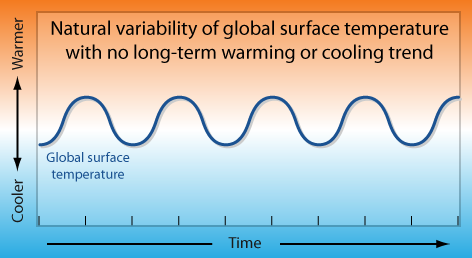
Figure 1 - diagram illustrating "natural variability" with a long-term average of zero.
The ocean heat content of the real world, however, is steadily increasing, and this affects global surface temperatures. Therefore if we take that natural oscillation, with a long-term average of zero, and now plot it on a warming trend:
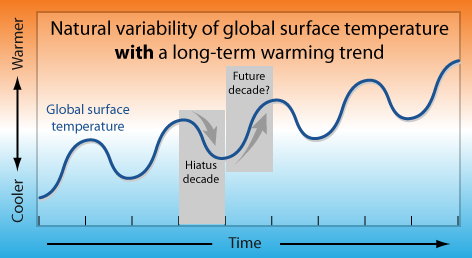
Figure 2 - diagram illustrating "natural variability" with a long-term warming trend.
We now see that the 'valleys' become shallower because they are superimposed on a climbing (warming) trend - these can be thought of as the hiatus decades. But note what happens to the peaks, they become steeper and higher, with each successive cycle climbing higher than the last.
The work of Meehl (2011) suggests that natural variability persists under conditions of global warming similar to the present, and that we may currently be in one of these decade-long hiatus periods. If so, we likely face a steep climb in global surface temperatures to the next peak of the natural cycle.
The ocean and global surface temperatures
Being in contact with the atmosphere, and covering about 70% of the Earth's surface, the ocean surface layer is the main source of atmospheric heating. The ocean absorbs sunlight and warms during the day, but as it is warmer than the air above it, the oceans release this heat to the cooler atmosphere above. Because of this, the temperature of the ocean surface layers, and the ocean-atmosphere heat exchange, exert a strong influence on global surface temperatures.
La Niña-like, El Niño-like, like what?
These phrases simply describe the characteristic state of the climate over the period observed. During La Niña there is strong upwelling of deeper cooler water in the tropical Eastern Pacific. When enough of this cooler water reaches the surface it causes cooling of global surface temperatures, due to the ocean surface-atmosphere heat exchange and the increased rainfall over land it produces.
The opposing phase in this natural cycle, is El Niño. During El Niño, the upwelling of cooler deep water in the tropical Eastern Pacific shuts off, heat in the surface layers (top 100 metres of ocean) builds up, and the ocean loses heat to the atmosphere. This, and subsequent reduced rainfall over land, results in the rise in global surface temperatures we typically associate with El Niño. See Trenberth (2002). (There is a great animation of ENSO (La Niña/El Niño) here).
Therefore, if the dominant pattern over a decade is La Niña-like, then we would expect global surface temperatures to stagnate - the hiatus decades in the model. This is seen in the Pacific Ocean heat content trends from the climate model used by Meehl (2011) below:
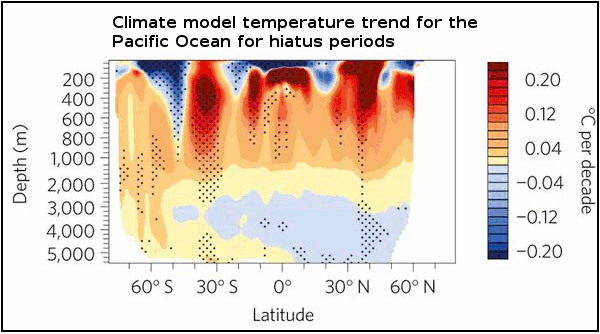
Figure 3 - Composite decadal trends of zonal-mean temperature trends for hiatus periods for the Pacific Ocean. From Meehl (2011)
The vertical profile shows heat (the warm-coloured areas in figure 3) accumulating in the subsurface ocean during the hiatus periods. At the same time the ocean surface, particularly the top 100 metres, shows a cooling trend. It's this La Niña-like cooling trend in the surface layers which stalls global surface temperatures, even though the layers underneath are gaining heat.
Funneling heat into the deep ocean
The oceans warm during La Niña-like hiatus periods, but how does heat get into the deep ocean, when much of the surface ocean is cooler-than-normal? Figure 4 is from Meehl (2011) and shows the areas of ocean where heat begins to pile up.
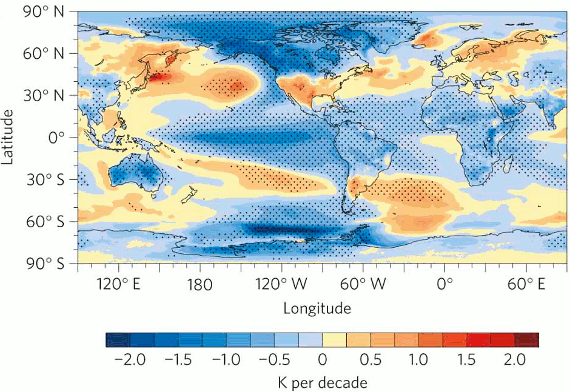
Figure 4 - Composite average global surface temperature trends for hiatus decades; stipling indicates 5% statistical significance (i.e a 5% probability the result was due to chance or statistical error). Orange-coloured ocean areas represent regions where OHC is converging and being driven down into the deep.
In the warm-coloured oceanic regions, heat is converging in the surface layers, and is being forced down to the deep ocean. An example of this strong downwelling of heat in the model is shown, for the upper Pacific Ocean, in Figure 5 below:
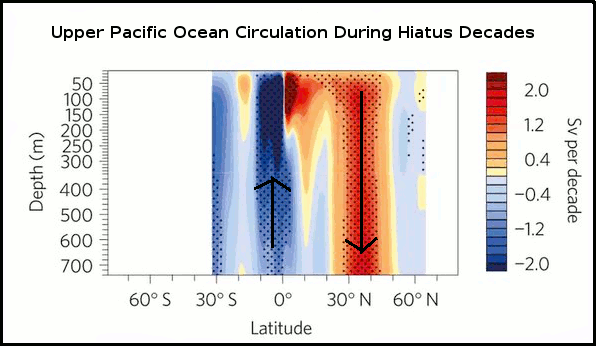
Figure 5 - composite decadal trends of meridional overturning stream function (i.e. ocean volume transport) for the upper Pacific Ocean for hiatus periods. Arrows added for clarity. Sv= sverdrup. From Meehl (2011).
Again this is very reminiscent of the upwelling of cool water in the Eastern Pacific, and the pooling of warm water in the Northern Pacific that is observed during La Niña.
No doubt many readers will identify these hiatus periods, as depicted in figure 4, as similar not only to La Niña, but to the pattern that arises during the negative phase of the Interdecadal Pacific Oscillation. In other words, the climate model is simulating well-observed phenomena, although we currently lack the instruments and data to verify all the details.
One more time
So to recap:
- Meehl (2011) is a climate model-based study that shows hiatus decades, of little or no increase in global surface temperatures, are relatively common even under conditions of global warming similar to the present.
- This see-sawing pattern of global surface temperatures has been apparent in climate model projections for some time now.
- These hiatus decades are simply the cool phase of a cool-warm natural cycle where heat is exchanged between the surface and subsurface ocean.
- The deep ocean warms during these hiatus decades because heat builds up in mid-latitude regions and is quickly funneled downwards.
- Heat buried in the deep ocean remains there for hundreds to thousands of years. It is not involved in the heat exchange occurring in shallower layers.
- Oceanic patterns in the hiatus decades are very similar to both La Niña and the Interdecadal Pacific Oscillation. So the model is simulating well-observed phenomena.
- The ocean, as a whole, is still steadily building up heat, so the next warm phase of this natural cycle may drive global temperatures to new record highs (the ocean heat coming back to haunt us).































 Arguments
Arguments






























[DB] Please provide a link plus an explanation of why it is relevant to this thread. Long quotations are considered poor etiquette and are frowned upon. Thanks!
Quoting resident statistical significance guru Dikran M,
Conclusions drawn from short periods should be treated very carefully; that's neither complicated nor anti-intuitive. " ... than is examining why we have these hiatus periods." Here is Tom Curtis the last time this came up:
That post dealt with the 'hiatus' via Kaufmann et al 2011, in terms of the slight changes in radiative forcing. Quoting,
Those are legitimate reasons why radiative forcing would briefly decrease (as illustrated in Figure 2), taking global temperatures on ‘hiatus.’ Are we now saying that explanation was insufficient? Because Meehl’s heat storage model requires no such drop in energy flux, as shown by the twin bars in left hand of Figure 3 here). So I’m with Peru on this: let’s save this model for some hiatus to come. "let's just say we disagree and leave it at that." Now that phrase is awfully familiar. I'm arguing neither the model nor the data, but let us at least have some consistency in how we reconcile the two.